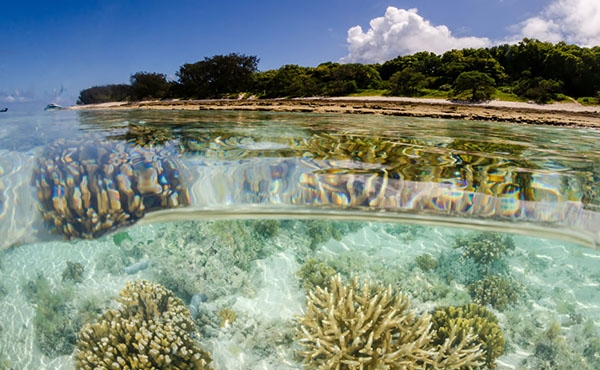Ocean salinity is a measure of the dissolved salts in sea water, often expressed as parts per thousand. The average salinity of the ocean is 35 parts per thousand (that is, each litre of sea water contains 35 grams of salt). Ocean salinity is driven by variations in the water cycle, including precipitation and evaporation, patterns of ocean mixing and terrestrial freshwater flows.761,762 Salinity is naturally more variable in coastal areas, where freshwater flows from rivers and coastal runoff have a significant influence, particularly during the wet season and following flood events.363 Fresh water is less dense than sea water, so low-salinity plumes tend to remain near the sea surface in unmixed inshore waters, which can lead to sharp gradients in salinity with depth.363 Inter-annual changes in salinity within the Region have been linked to large-scale climate drivers, such as the El Niño–Southern Oscillation.739,763
Global climate change is altering and intensifying the water cycle, affecting ocean salinity
Salinity determines the distribution of both marine and estuarine species at all trophic levels. Changes in salinity can affect growth, respiration, photosynthesis, behaviour, reproduction and enzymatic capacity, ultimately affecting ecosystem structure and function.764,765 Within the Region, low salinities affect seasonal fish community composition in estuaries,766 limit coral growth rates, cause reduced flowering in seagrasses 767 and may decrease survival of crown-of-thorns larvae.768 Low-salinity events associated with floodwaters can cause extensive mortality in a range of reef species, including corals, crustaceans, molluscs, sponges, fishes and seagrasses.572,765,767 Coral mortality as a direct result of low salinity has been limited to depths of up to 2 metres on reefs closest to rivers during major flood events.185 Experiments suggest that while juvenile corals are highly sensitive to low salinity, they may have some potential to acclimatise following short-term exposure.769 Low salinity compounds the effect of increasing temperatures on coral condition and survival,570 whereas high salinities may increase temperature tolerance in some species.770 Furthermore, low salinity combined with increased organic matter may contribute to outbreaks of coral disease.578
Global climate change is altering and intensifying the water cycle and these changes affect ocean salinity.761,762 On a large scale, open ocean waters in the subtropical Pacific are becoming saltier at the near surface, and this pattern is predicted to continue under future projections.762,765 Consistent with this, measurements from 2 fixed stations within the Region recorded increasing seawater salinity from 2009 to 2019, although seasonal decreases were associated with high freshwater inflow during particularly wet summer months.739
In inshore areas within the Region, changes in salinity are largely influenced by freshwater inflows. Freshwater discharges are naturally high in the Wet Tropics region, where flows have been relatively close to the long-term average over the past 5 years. Freshwater flows in the Burdekin, Mackay and Whitsunday regions were higher than the long-term average during 2019 and 2023.579,771 Low-salinity flood plumes, in combination with other acute disturbances, have affected the condition of inshore coral communities in the Region over this period.185 The projected increases in extreme rainfall associated with climate change540 suggest the impacts of low salinity may increase in future for inshore areas within the Region.
Wider ocean patterns suggest that salinity may slowly increase in offshore areas within the Region, while inshore areas are subject to seasonal decreases in salinity as a result of freshwater input. Over the past 5 years, freshwater influence has been slightly above average overall with regional variation.


